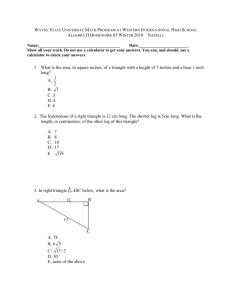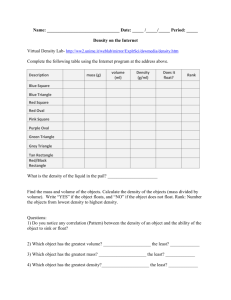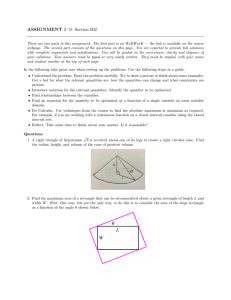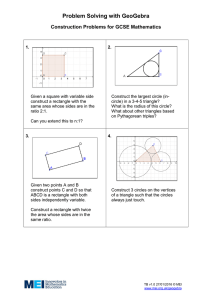Math 104 - Fall 2012
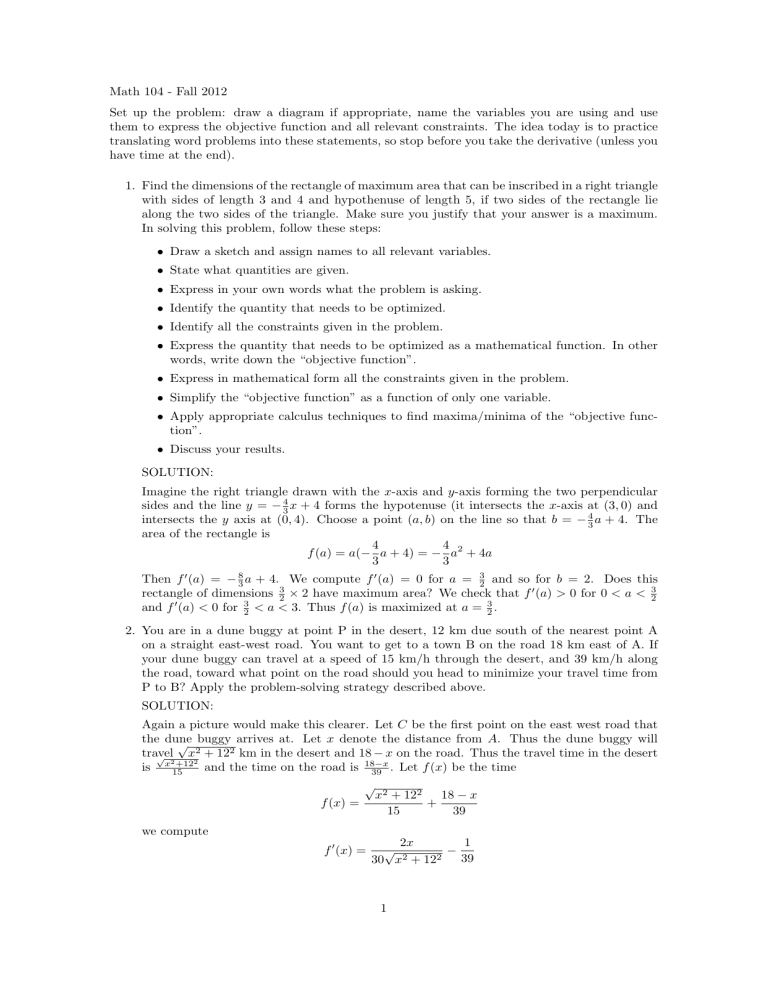
Math 104 - Fall 2012
Set up the problem: draw a diagram if appropriate, name the variables you are using and use them to express the objective function and all relevant constraints. The idea today is to practice translating word problems into these statements, so stop before you take the derivative (unless you have time at the end).
1. Find the dimensions of the rectangle of maximum area that can be inscribed in a right triangle with sides of length 3 and 4 and hypothenuse of length 5, if two sides of the rectangle lie along the two sides of the triangle. Make sure you justify that your answer is a maximum.
In solving this problem, follow these steps:
• Draw a sketch and assign names to all relevant variables.
• State what quantities are given.
• Express in your own words what the problem is asking.
• Identify the quantity that needs to be optimized.
• Identify all the constraints given in the problem.
• Express the quantity that needs to be optimized as a mathematical function. In other words, write down the “objective function”.
• Express in mathematical form all the constraints given in the problem.
• Simplify the “objective function” as a function of only one variable.
• Apply appropriate calculus techniques to find maxima/minima of the “objective function”.
• Discuss your results.
SOLUTION:
Imagine the right triangle drawn with the x -axis and y -axis forming the two perpendicular sides and the line y = − 4
3 x + 4 forms the hypotenuse (it intersects the x -axis at (3 intersects the y axis at (0 , 4). Choose a point ( a, b ) on the line so that b = − 4
3 a
, 0) and
+ 4. The area of the rectangle is f ( a ) = a ( −
4
3 a + 4) = −
4
3 a
2
+ 4 a
Then f
3 rectangle of dimensions and f
0
(
0 a
( a ) = −
) < 0 for
8 a + 4. We compute f
3
2
3
2
< a <
0
( a ) = 0 for a =
3 and so for b = 2. Does this
2
× 2 have maximum area? We check that f
0
( a ) > 0 for 0 < a <
3
2
3. Thus f ( a ) is maximized at a =
3
2
.
2. You are in a dune buggy at point P in the desert, 12 km due south of the nearest point A on a straight east-west road. You want to get to a town B on the road 18 km east of A. If your dune buggy can travel at a speed of 15 km/h through the desert, and 39 km/h along the road, toward what point on the road should you head to minimize your travel time from
P to B? Apply the problem-solving strategy described above.
SOLUTION:
Again a picture would make this clearer. Let C be the first point on the east west road that the dune buggy arrives at. Let x denote the distance from A . Thus the dune buggy will travel is x x 2 +12 2
2
15
+ 12 2 km in the desert and 18 − x on the road. Thus the travel time in the desert and the time on the road is 18 − x
39
. Let f ( x ) be the time
√ x 2 + 12 2 f ( x ) =
15
+
18 − x
39 we compute f
0
( x ) =
30
√
2 x 2 x
+ 12 2
1
−
39
1
Now f so 13
2
0 x
( x ) = 0 for
2
= 5
2
( x
2
30
√
+ 12
2 x x
2
2 +12 2
=
1
39
) and so 12
2 and so 78 x
2
= 5
2 x
12
2
= 30
√ x and so
2 x
+ 12 2 and so 13 x = 5
= 5 (we may discard
√ x x 2
=
+ 12
−
2 and
5 which must be worse than x = 5). We check the signs of the derivative to ensure that x = 5 yields a minimum for f ( x ), the travel time.
3. A piece of wire 10 cm long is cut into two peices. One piece is bent into a circle while the other is bent into an equilateral triangle. How should the wire be cut so that the total area enclosed is minimal? Maximal?
SOLUTION:
Divide the wire into pieces of length x and 10 − x forming equilateral triangle and circle respectively. The side length of the triangle is x/ 3 giving area (1 / 2) · x/ 3 · x 3 / 6. For the circle 2
A x
( x ) =
= 90
A (90 / (
πr x
(
3
2
√
π
= 10
3 /
+ 9))
−
≈ x
3 .
giving
36 + (10 − x )
πr
2
/
2
(4
=
π
π (10
00. The min is 3 .
−
). Thus
00cm x
A
0
2
)
2
/ (2 π )
2
( x ) = x
√
3 / 18 − and the max is 7
(10
.
−
96cm x
2
.
) / (2
3 π + 9) ≈ 6 .
23. We find A (0) = 25 /π ≈ 7 .
96 , A (10) = 25 3
).
/ 9
A
0
≈
( x
4
) = 0
.
82 ,
⇒ and
4. A right circular cone is turned upside-down (vertex is at the bottom); the height of cone is
10 cm and the diameter of the top is also 10 cm. The cone is filled half-way (by depth), and water is draining out. The depth of the water is dropping at a rate of 4 cm per second. How fast is the volume of the water changing at this time? You may use the fact that the volume of a cone with radius r and height h is πr 2 h/ 3.
SOLUTION:
The height of the cone is 10 and the radius is 5. By similar triangles (use a picture) we have that
( π/ 4) h
2 r =
5
10 h = h/ 2.
Using V =
1
3
π ( r
2 h ) we have V = ( π/ 12) h
3 so dV /dt =
( dh/dt ) = ( π/ 4)(100)( − 4) = − 100 π , i.e. the volume of water is decreasing at a rate of 100 π cubic cm per second.
5. A shoebox, complete with overlapping lid, has a base with length 5/3 times its width. The rim of the lid overlaps the side of the main box by 1/5 of the height of the box. Assuming the thickness of the box is negligible and of uniform density, and the total volume of the box is 3000 cubic centimetres, what dimensions will result in the minimum weight of the empty box? Make sure you follow the steps outlined in the problem-solving strategy above. Draw a picture of the box and remember that if your computations lead to large numbers you can always express such numbers as a product of their factors: this will help you to carry out algebraic calculations by hand.
SOLUTION:
The problem is more about accounting carefully for the weight. Let l denote the length, let w denote the width, and let h denote the height. We have been told the length is 5 / 3 times the width, namely l =
5
3 w
Also the volume is 3000 and so wlh = 3000 and so we can substitute for l and so
5
3 w
2 h = 3000
From this we can express h in terms of w and deduce that h =
1800 w 2
The amount or area of cardboard is proportional to the weight (from the uniform density hypothesis). The area of the bottom of the box is wl + 2 lh + 2 wh the area of the lid is wl + 2 l h
5
+ 2 w h
5
2
and so the total area is
2 wl + (2 l + 2 w )
6
5 h
If we substitute for l, h we get that total area is
A ( w ) =
10 w
3
2
+ (
16
3 w )
6
5
1800 w 2
=
10 w
2
3
+
2160 w
We wish to minimize the area and so we differentiate to get
A
0
( w ) =
20 w −
3
11520 w 2
Thus
A
0
A
0
( w ) = 0 for w
3
= 11520 × 3
20
= 1728 = (12)
3 and so for w = 12. Thus we have
( w ) = 0 for w = 12 and so l = 20 and h = 12 .
5. The lid will have depth
1
5
12 .
5 = 2 .
5
Now we might not be sure that this is the minimum area but can verify that our solution is a local minimum. The possible values for w are 0 < w . For w → 0 we have l → 0 and so h → ∞ but in order to have a volume of 3000, we can show that A ( w ) → ∞ . For w → ∞ we have l → ∞ and h → 0 and so as w → ∞ we have A ( w ) → ∞ just based on the top and bottom surfaces.
6. The price p in $ for a product and the quantity q of demand (that is, the quantity of units sold) for a product are related by the equation p 2 + 2 q 2 = 1100. If the price is increasing at a rate of $2 per month when the price is $30, find the rate of change of the revenue R in dollars per month.
SOLUTION:
The price p and demand q are related by the equation p
2
+ 2 q
2
= 1100
. Thus d dt
( p
2
+ 2 q
2
) = 2 p dp dt
+ 4 q dq dt
= d dt
(1100) = 0
We are given that have dp dt
= 2 and that currently p = 30. Substituting into our first equation we
(30)
2
+ 2 q
2
= 1100 and so q
2
= 100 and so q = 10 where we discard the negative root. Substituting in the above equation p = 30, q = 10 and dp dt
= 2, we have 2 × 30 × 2 + 4 × 10 × dq dt
= 0 from which we solve to obtain dq dt
= − 12
4
= − 3 units per month.
We are asked for d dt
R = d dt pq = dp dt q + p dq dt
= 2 × 10 + 30 × ( − 3) = − 70 a rate of change of $ − 70 per month. Thus revenue is decreasing with respect to time. (As price increases, demand goes down but the overall revenue is decreasing.)
3
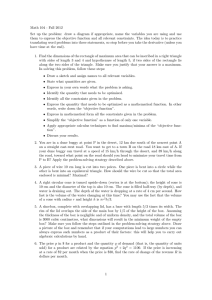
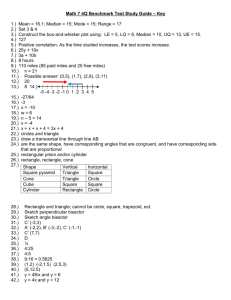
![Math 131 Practice Exam 3 on [ -1, 4].](http://s2.studylib.net/store/data/010538103_1-a851ef52d08f89241a99ddd9d94bbb2a-300x300.png)
